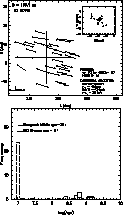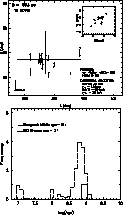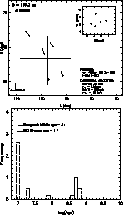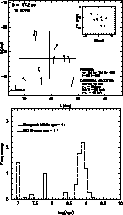

Up: The distribution of nearby Hipparcos
Subsections
(X, Y, Z) distributions range from -125 pc to +125 pc and are binned in a Sun
centered orthonormal frame, X-axis towards the galactic center, Y-axis in the
rotation direction and Z-axis towards the north galactic pole. The discrete wavelet
analysis is performed on five scales: 9.7, 13.6, 21.5, 37.1 and 68.3 pc. These values
correspond to the size of the dilated filter h at each scale.
Stars belonging to each volume defined by significant coefficients are collected. Due
to the over-sampling of the signal by the "à trou'' algorithm, some structures are
detected on several scales. A cross-correlation has been done between all scales to
keep the structure at the largest scale provided that there is no sub-structure at a
lower scale (higher resolution). We control a posteriori the efficiency of the
detection by calculating for each over-density the probability to find an identical
concentration from the total volume of the sample in a uniform random population (see
probability P2 in Table 1). The method also succeeds in finding
over-densities with a high probability to be generated by a poissonian process. An
iterative 2.5 sigma clipping procedure is done on tangential velocity distributions for
each group to remove field stars and select structures with coherent kinematics
(Table 1 and Figs. 6, 7, 8,
9 and 10).
 |
Figure 6:
Lower Centaurus-Crux after selection on tangential velocities (top) and
its age distribution (bottom) |
Table 1:
Main characteristics of detected spatial structures after iterative
2.5 sigma clipping procedure on tangential velocities: galactic coordinates
(l,b), distance D, mean tangential velocities
( ,
,  ), tangential velocity
dispersions (
), tangential velocity
dispersions ( ,
,  ), number of
selected stars
), number of
selected stars  . Other parameters are given: scales of detection
S, volume v occupied by the total over-density, number of expected
stars
. Other parameters are given: scales of detection
S, volume v occupied by the total over-density, number of expected
stars  in this volume according to the mean density, number of
observed stars
in this volume according to the mean density, number of
observed stars  before selection on tangential velocities, probability
P1 to find such a concentration from a poissonian distribution in this v
volume and probability P2 to find this volume v with this concentration
within the 125 pc radius sphere. A value of .001 indicates a probability
before selection on tangential velocities, probability
P1 to find such a concentration from a poissonian distribution in this v
volume and probability P2 to find this volume v with this concentration
within the 125 pc radius sphere. A value of .001 indicates a probability

 |
The volumes selected by the segmentation procedure content 10 per cent of the stars.
After the 2.5 sigma clipping procedure on the tangential velocities, only 7 per cent
are still in clusters or groups. Most of them are well known: Hyades,
Coma Berenices, Ursa Major open clusters (hereafter OCl) and the Scorpio-Centaurus
association. The following cases are the most interesting either because of newly
discovered features associated to well known structures (Scorpio-Centaurus
association) or simply because they were undetected up to now (Bootes and Pegasus 1
and 2).
- 1.
- The Scorpio-Centaurus association shows three precisely limited
over-densities with an elongated shape crossing the galactic disc (see scale 4 on
Paper II, Fig. 5): lower Cen-taurus-Crux, upper Centaurus-Lupus which both have
identical proper motions and a third unknown clump at
 ,
, with slightly different proper motions along l axis (see cluster 9
in Table 1). We do not find previous mention of this extension of the
Scorpio-Centaurus. Unfortunately very few of these stars have Strömgren photometry.
In the case of Centaurus-Crux (see Figs. 6), among 33 stars, 3 stars
having a Strömgren age are rather old. One of these stars is flagged as a double
system in the
Hipparcos catalogue, which could alter the Strömgren
photometry. The two others probably do not belong to the association but are not
rejected by the selection on tangential velocities because of proper motions close to
the association ones. However this association is known to be an O-B association,
which means that it is younger than a few tens of million years.
The palliative age distributions show that all the three clumps are composed by the
youngest stars of the sample. The analysis of the velocity field (see
Sect. 5.3.1) reveals that these density inhomogeneities are embedded in a
stream-like structure moving through all the 125 pc sphere.
with slightly different proper motions along l axis (see cluster 9
in Table 1). We do not find previous mention of this extension of the
Scorpio-Centaurus. Unfortunately very few of these stars have Strömgren photometry.
In the case of Centaurus-Crux (see Figs. 6), among 33 stars, 3 stars
having a Strömgren age are rather old. One of these stars is flagged as a double
system in the
Hipparcos catalogue, which could alter the Strömgren
photometry. The two others probably do not belong to the association but are not
rejected by the selection on tangential velocities because of proper motions close to
the association ones. However this association is known to be an O-B association,
which means that it is younger than a few tens of million years.
The palliative age distributions show that all the three clumps are composed by the
youngest stars of the sample. The analysis of the velocity field (see
Sect. 5.3.1) reveals that these density inhomogeneities are embedded in a
stream-like structure moving through all the 125 pc sphere.
Two new structures are found both probably on their way towards disruption. In the following
these loose clusters are designated after the constellation they are found in.
 |
Figure 7:
Coma Berenices open cluster after selection on tangential velocities (
top) and its age distribution (bottom) |
 |
Figure 8:
Bootes loose cluster after selection on tangential velocities (top) and
its age distribution (bottom) |
- 2.
- Bootes (Fig. 8) is composed of only 5 stars at a mean distance
of 105 pc and centred on
 . This small clump is
interesting for several reasons. It is located at the same x and z coordinates as
Coma Ber. OCl (Fig. 7) but 62 pc ahead along y-axis with exactly the
same space velocity components (U, V, W)=(-3.1, -7.8, -0.8) km s-1.
These coincidences suggest a common origin for these two structures. But their
respective age distributions (Figs. 7 and 8) show that
Bootes is probably younger (peak at 107 yr for the palliative age distribution)
than Coma Ber. OCl which is
. This small clump is
interesting for several reasons. It is located at the same x and z coordinates as
Coma Ber. OCl (Fig. 7) but 62 pc ahead along y-axis with exactly the
same space velocity components (U, V, W)=(-3.1, -7.8, -0.8) km s-1.
These coincidences suggest a common origin for these two structures. But their
respective age distributions (Figs. 7 and 8) show that
Bootes is probably younger (peak at 107 yr for the palliative age distribution)
than Coma Ber. OCl which is  yr old. Moreover, the smaller
tangential velocity dispersions of Bootes tends to confirm this hypothesis. A more
detailed investigation among other spectral types is necessary to better define Bootes
in velocity space as well as in age content.
yr old. Moreover, the smaller
tangential velocity dispersions of Bootes tends to confirm this hypothesis. A more
detailed investigation among other spectral types is necessary to better define Bootes
in velocity space as well as in age content.
 |
Figure 9:
Pegasus 1 after selection on tangential velocities (top) and its age
distribution (bottom) |
 |
Figure 10:
Pegasus 2 after selection on tangential velocities (top) and its age
distribution (bottom) |
- 3.
- Pegasus appears to be composed of two different velocity components
(Figs. 9, 10). This feature do not permit to extract
coherent velocity structures by means of the sigma clipping procedure. A hand selection
was realized on the basis of the whole tangential velocity distribution.
Pegasus 1 with
10 stars and Pegasus 2 with 8 stars are obtained with mean distances of respectively
97 and 89 pc and centred on
 and
and
 . Their age distributions are not very precise because
of the lack of Strömgren ages. However, it seems that Pegasus 1 has an age peak at
8 108 yr. It has no very young ages but 3 Strömgren ages are between
8 108 and 1.2 109 yr which would mean an age older than Pegasus 1.
This complex structure gives an instantaneous snapshot of the interactions affecting
groups, clusters or associations: merging-like process can take part in dissolving
spatial inhomogeneities.
. Their age distributions are not very precise because
of the lack of Strömgren ages. However, it seems that Pegasus 1 has an age peak at
8 108 yr. It has no very young ages but 3 Strömgren ages are between
8 108 and 1.2 109 yr which would mean an age older than Pegasus 1.
This complex structure gives an instantaneous snapshot of the interactions affecting
groups, clusters or associations: merging-like process can take part in dissolving
spatial inhomogeneities.


Up: The distribution of nearby Hipparcos
Copyright The European Southern Observatory (ESO)


